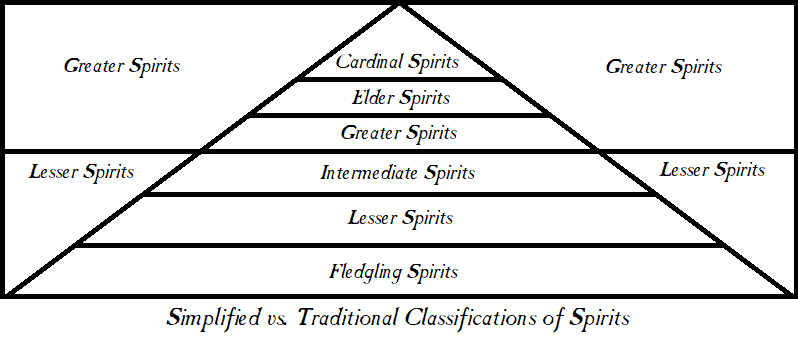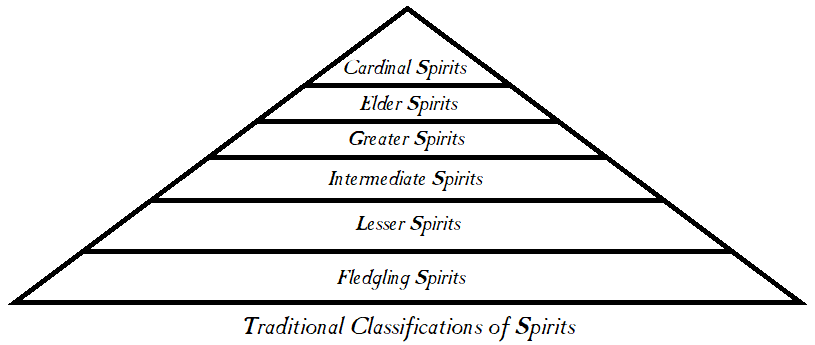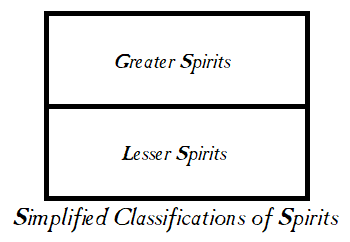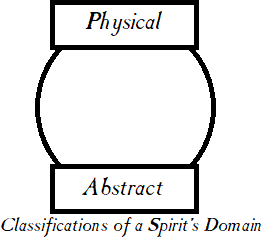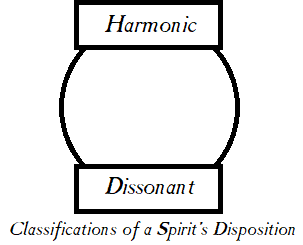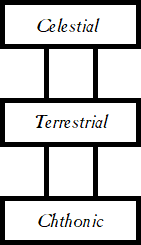The Classifications of Spirits
An Introduction into Spiritual Classification[edit]
Due to the importance of the Spirits and the great variety between them, there have been multiple systems of classification created for them. Many fell apart over the years, and others have persevered. This article seeks to compile the different systems of classification for the spirits, and in so doing spread the knowledge of spirits amongst the general populace. It is very important to note that these classifications are human constructs, and may not necessarily represent how the Spirits themselves classify themselves.
The first and foremost systems of classifying spirits is based off of multiple categories: the scale of their Domain, their general age, and their significance to Rhyst. There are two main systems that reflect this, known as the Simplified Classifications and the Traditional Classifications. The former are used more often, yet are somewhat more vague about more mid-lining Spirits; while the latter has more categories and is typically used in more scholarly fields for the added specificity it brings.
The other three systems are far less commonly used, but instead look at the spirit's Domain and their disposition to place them upon different scales. They are more often than not used by scholars to add additional specificity to the different spirits of Rhyst.
Traditional Classifications of Spirits[edit]
The Traditional Classifications of Spirits are typically used by either scholars or by followers of the spirits for a greater degree of specificity when talking of the spirits. It splits the categories of 'Greater' and 'Lesser' Spirits into three each, and it provides a more accurate scale for the different spirits.
First of the Classifications are the Cardinal Spirits; referencing the five greatest spirits of Rhyst. Vaiel, Eschen, Hysena, Ai, and Phee; who represent the cardinal directions upon the Wheel of Rhyst.
Second of the Classifications are the Elder Spirits; referencing the next tier of powerful spirits of Rhyst. Helios, Amada, Samsara, Melous, Delta, Sylva, Zephyr, and Zeal.
Third of the Classifications are the Greater Spirits; referencing those spirits of Rhyst that hold domain over large swathes of lands. They reign over continents, entire countries worth of land, or over vast domains.
Fourth of the Classifications are the Intermediate Spirits; referencing those spirits of Rhyst that hold larger than standard domains. These are the spirits of forests, of lakes, or of hills.
Fifth of the Classifications are the Lesser Spirits; referencing those spirits of Rhyst that hold small domains. These are the spirits of trees, of creeks, of ponds, and so forth. They are typically the weakest, and the Elementals commonly found throughout the more magically inclined lands of Rhyst typically fall into this category.
Sixth and final of the Classifications are the Fledgling Spirits; referencing those spirits of Rhyst that are the absolute youngest and absolute weakest. Their domains are small; a single flower, a tree's sapling, and so forth.
Simplified Classifications of Spirits[edit]
The Simplified Classifications of the Spirits places them all within two categories: Greater, and Lesser. For most people this is enough; as there is no reason to go too in-depth as to the classification of a spirit in everyday conversation, but it holds some issues when used in reference to those spirits that lay between Greater and Lesser Spirits. It simplifies the classifications, although in so doing it loses a large amount of usefulness in specificity in regards to mid-lining Spirits.
The Cardinal, Elder, and Greater Spirits of the Traditional Classifications fall under the Simplified Classification's category of Greater Spirits.
The Intermediate, Lesser, and Fledgling Spirits of the Traditional Classifications fall under the Simplified Classification's category of Lesser Spirits.
Classifications of Spirits Domains[edit]
The Classifications of a Spirit's Domain looks at their Domain rather than the spirit itself, and places them on a scale between the Physicality and the Abstractness of the Domain. Those that are more Physical tend to be the closest to the Elements, while those that are Abstract tend to be closer to Weaving magics- such as the Arcane.
Physical Domains refer to those that are physical locations. These are rivers, forests, mountains, and so forth; and those spirits with Physical Domains tend to be the oldest spirits. However they also tend to grow the slowest as a tree does not become a forest overnight, and their power is usually somewhat lower than those with Abstract Domains.
Abstract Domains refer to those that are metaphysical concepts. Commerce, War, Law, and so forth. Those spirits with Abstract Domains tend to be the youngest spirits, as their domains are more often than not tied to mortals, although they also tend to grow much faster and grow to be stronger that those with Physical Domains. As a drawback, however, should their concept Domain fall into decline, so shall the spirit.
It should be noted that the strongest and eldest of spirits have both Physical and Abstract aspects to their Domains.
Classifications of Spirits disposition[edit]
The Classifications of a Spirit's Disposition looks at neither their Domain nor their general power, but rather at their relationship with humans, other spirits, and most life within Rhyst. It compares how Harmonic or Dissonant one is with their environment, and this system of classification is rarely looked at by the standard layperson; as more often than not, Dissonant spirits are simply destroyed.
Harmonic Spirits are those that are friendly, peaceful, and generally very attuned with their environment. They will typically be worshipped as benevolent deities, and tend to receive offerings to thank them for whatever it is they do. These are the spirits most people are favorable towards.
Dissonant Spirits are those that are unfriendly, aggressive, and very territorial. They tend to represent the darker aspects of Rhyst, and will usually be worshipped as malevolent deities; and they tend to receive offerings to placate them. Lesser Dissonant Spirits are typically fought off by soldiers, while Greater Ones are typically avoided or sealed away.
It should be noted, that Dissonant and Harmonic spirits are both natural parts of Rhyst. Without 'Evil,' 'Good' holds no purpose; and without 'Good,' 'Evil' remains undefinable. They serve as foils to one another to maintain another system of balance within Rhyst.
Classifications of Spirits Physical Domains[edit]
The final Classification of Spirits is by far the one least looked at, as it primarily deals with those spirits with Physical Domains; and it deals more specifically with the location of their Domain. It sorts them into Celestial, Terrestrial, and Chthonic Domains.
Celestial Domains are those that exist above the ground. These are Spirits of the Sky, of Clouds, and so forth.
Terrestrial Domains are those that exist upon the ground. These are Spirits of the Forests, of Swamps, or Plains, and so forth.
Chthonic Domains are those that exist below the ground. These are Spirits of Metals, of Magma, and so forth.
Credit[edit]
Retatouille https://forum.verdict.dev/showthread.php?tid=1123
